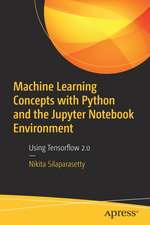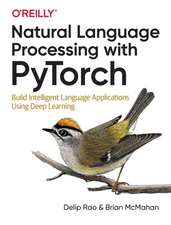Image Processing and Acquisition using Python: Chapman & Hall/CRC The Python Series
Autor Ravishankar Chityala, Sridevi Pudipeddien Limba Engleză Hardback – iul 2020
| Toate formatele și edițiile | Preț | Express |
|---|---|---|
| Paperback (1) | 359.66 lei 3-5 săpt. | +33.69 lei 4-10 zile |
| CRC Press – 29 apr 2022 | 359.66 lei 3-5 săpt. | +33.69 lei 4-10 zile |
| Hardback (1) | 914.57 lei 6-8 săpt. | |
| CRC Press – iul 2020 | 914.57 lei 6-8 săpt. |
Din seria Chapman & Hall/CRC The Python Series
-
 Preț: 287.67 lei
Preț: 287.67 lei - 20%
 Preț: 304.23 lei
Preț: 304.23 lei -
 Preț: 358.50 lei
Preț: 358.50 lei - 20%
 Preț: 385.04 lei
Preț: 385.04 lei - 20%
 Preț: 369.86 lei
Preț: 369.86 lei - 20%
 Preț: 284.19 lei
Preț: 284.19 lei - 8%
 Preț: 526.25 lei
Preț: 526.25 lei - 20%
 Preț: 320.69 lei
Preț: 320.69 lei - 20%
 Preț: 165.54 lei
Preț: 165.54 lei - 8%
 Preț: 452.90 lei
Preț: 452.90 lei -
 Preț: 387.31 lei
Preț: 387.31 lei - 20%
 Preț: 397.43 lei
Preț: 397.43 lei - 20%
 Preț: 298.92 lei
Preț: 298.92 lei - 8%
 Preț: 397.26 lei
Preț: 397.26 lei -
 Preț: 359.66 lei
Preț: 359.66 lei - 20%
 Preț: 330.77 lei
Preț: 330.77 lei
Preț: 914.57 lei
Preț vechi: 1115.33 lei
-18% Nou
175.02€ • 181.69$ • 145.94£
Carte tipărită la comandă
Livrare economică 24 martie-07 aprilie
Specificații
ISBN-10: 0367198088
Pagini: 452
Ilustrații: 143 Illustrations, black and white
Dimensiuni: 156 x 234 x 31 mm
Greutate: 0.89 kg
Ediția:Nouă
Editura: CRC Press
Colecția Chapman and Hall/CRC
Seria Chapman & Hall/CRC The Python Series
Cuprins
Notă biografică
Sridevi Pudipeddi, Ph.D. has eleven years of experience teaching undergraduate courses. She teaches Machine Learning with Python and Python for Data Analysis at the University of California Berkeley at San Francisco campus. Dr. Pudipeddi's research interests are in machine learning, applied mathematics and image and text processing. Python's simple syntax and its vast image processing capabilities, along with the need to understand and quantify important experimental information through image acquisition, have inspired her to co-author this book. Dr. Pudipeddi co authored Essential Python (Essential Education, California, 2018).
Recenzii
—Midwest Book Review
Reviews for the previous edition
"This multi-disciplinary image processing guide hits the mark when targeting the introductory college-level user who is interested in an open source solution that is scalable. By approaching the topics in a broad and horizontal fashion, Ravi Chityala and Sridevi Pudipeddi have created a very practical resource that should have broad impact and appeal across multiple physical and biological disciplines while using multiple imaging modalities.
This new book uses an intuitive and efficient structure to describe basic acquisition hand-in-hand with image processing topics using the open source Python coding and even provides pre-packed installations. The authors present an effective approach to address the typical requirement of prerequisite image acquisition, computational knowledge, and/or hardware requirements by carefully balancing programming, math, and computer requirements, making image processing accessible to students and high-end users alike in multiple disciplines."
—Mark A. Sanders, Program Director, University Imaging Centers, University of Minnesota
"This is a well-suited companion for any introductory course on image processing. The concepts are clearly explained and well illustrated through examples and Python code provided to the reader. The code allows the reader to readily apply the concepts to any images at hand, which significantly simplifies the understanding of image processing concepts. This is what makes this book great. I recommend this book to researchers and students who are looking for an introduction to image processing and acquisition."
—Martin Styner, University of North Carolina at Chapel Hill
"I am a faculty member with specialization in biomechanics and have often found it hard to conceptualize the fundamentals of image processing. That is until I found this book. Image Processing and Acquisition using Python is unique in that it offers an in-depth understanding of the foundation of mathematics associated with image analysis. Ravi Chityala and Sridevi Pudipeddi provide accessible examples with sample codes to show how the theories are applied. This can be very useful to beginning learners and also for researchers (having Python sample code can be very handy to prototype a solution). This book touches all the fundamental topics on image processing, such as pre/post processing using filters, segmentation, morphological operations, and measurements, and also an in-depth discussion on image acquisition using various modalities like x-ray, CT, MRI, light microscopy, and electron microscopy. All the topics are explained clearly and easily. I would highly recommend this book and cannot praise enough the logical and well-written format that it is presented in."
—Augusto Gil Pascoal, Laboratory of Biomechanics and Functional Morphology, University of Lisbon
"This is a book that every imaging scientist should have on his or her desk … students and researchers need a course or a book to learn both image acquisition and image processing using a single source, and this book, as a well-rounded introduction to both topics, serves that purpose very well. … the authors have done a great job of covering the most commonly used image acquisition modalities … a handy compendium of the most useful information. … As a long-time Perl user, I had no problem installing Python and trying several useful examples from the book."
—From the Foreword by Alexander Zamyatin, Distinguished Scientist, Toshiba Medical Research Institute USA, Inc.
"The parts on Python and image processing are the strengths of the book. I enjoyed these parts and heavily profited from them – in fact they saved me a lot of time – so that I can highly recommend the whole book. The book actually motivated me, as MATLAB® user for two decades, to migrate to Python. Furthermore, I will use this book as textbook for Python and image processing for my future classes in the imaging and processing lab that I teach."
—Professor Andreas Modler, Beuth University for Applied Sciences
"The parts on Python and image processing are the strengths of the book. I enjoyed these parts and heavily profited from
them – in fact they saved me a lot of time – so that I can highly recommend the whole book. The book actually motivated
me, as MATLAB® user for two decades, to migrate to Python. Furthermore, I will use this book as textbook for Python and
image processing for my future classes in the imaging and processing lab that I teach."
- Andreas Modler, Beuth University of Applied Sciences, Germany
Descriere
Image Processing and Acquisition using Python, Second Edition provides readers with a sound foundation in both image acquisition and image processing--one of the first books to integrate these topics. By improving readers' knowledge of image acquisition techniques and corresponding image processing, the book will help them perform experiments more effectively and cost efficiently as well as analyze and measure more accurately. Long recognized as one of the easiest languages for non-programmers to learn, Python is used in a variety of practical examples.
A refresher for more experienced readers, the first part of the book presents an introduction to Python, Python modules, reading and writing images using Python, and an introduction to images. The second part discusses the basics of image processing, including pre/post processing using filters, segmentation, morphological operations, and measurements. The second part describes image acquisition using various modalities, such as x-ray, CT, MRI, light microscopy, and electron microscopy. These modalities encompass most of the common image acquisition methods currently used by researchers in academia and industry.
Features
- Covers both the physical methods of obtaining images and the analytical processing methods required to understand the science behind the images.
- Contains many examples, detailed derivations, and working Python examples of the techniques.
- Offers practical tips on image acquisition and processing.
- Includes numerous exercises to test reader skills in Python programming and image processing, with solutions to selected problems, example programs, and images available on the book's CRC Press web page.
New to this edition
- Machine learning has become an indispensable part of image processing and computer vision, so in this new edition two new chapters are included: one on neural networks and the other on convolutional neural networks.
- A new chapter on affine transform and many new algorithms.
- Updated Python code aligned to the latest version of modules.



























